
OceansArt.US
|
Access to most visitors to the Ballestas Islands and all of the Paracas National Reserve is from the Port of El Chaco, just south of Pisco. Pisco Ciudad (City) is within the province of Pisco and is its capital. It is in the Nazca Desert. The city is around 9 metres (28 feet) above sea level. Pisco originally prospered because of its nearby vineyards, and is the namesake of the Peruvian grape liquor, pisco.
Pisco is a city and an important port on the Peruvian coast. The name originates from the Inca word for a bird, one of the mysterious designs on the Nazca plateau. The surrounding valleys, born in the Andes Mountains, contain extremely fertile soils which have lent themselves to grape cultivation. Pisco has not only given its name to Peru's national drink, one of the highest quality liqueurs and symbol of the Peruvian tradition but it is also the center of its production and distribution worldwide.
The Pisco origins are from one of the major ancient
civilizations in Peru, the Paracas culture. Due to its ease of access, and
its crossroads to the Andes the Spanish considered making Pisco the capital,
before they decided on Lima.
In the city is the Plaza de Armas, where people hang out and buy tejas, small
sweets made from pecans and assorted dried fruits. Among the different buildings
that surround the Plaza are the statue of José de San Martín,
the mansion he lived in, and the Municipal Palace. Others include the heavy
Baroque Iglesia de la Compañía, begun in 1689.
Near the town, just off the road to Ayacucho, lies the large well-preserved
Inca site of Tambo Colorado.
The city has a population of 116,865 people.There are hotels in Pisco and its evirons including
near the Paracas Reserve, and El Chaco harbor.
Along the shores between Pisco and the Paracas Park are many types of commercial fishing vessels, mostly tuna seiners and anchovy and sardine purse seiners, and a multitude of skiffs held at anchor or hauled onto the beach when not at sea.
(Adapted from: Pisco, Peru. (2008). From Wikipedia, The Free Encyclopedia and from the Embassy of Peru)
See all the free photos, including other photos of Peru by going to the Photo Catalog. Click on any picture for a FREE larger version. Read the licensing rules (REVISED) for your needs. There are hundreds of high quality free photos: use the Google/site search engine. See our digital photography tips : DOs and Don'ts; Choosing a Camera and Accessories , Downloading Photos, and Editing Photos. Visit TechnologySite.org for free photos and lists of inventions and technology and learn Climate Change Facts to see for yourself if your area is at risk from global warming or global cooling.
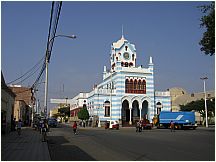 29pisco.jpg Church just off the Plaza de Armas of Pisco, Peru |
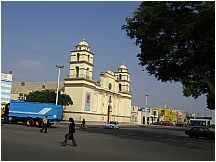 30pisco_.jpg Church of the Company of Jesus on the Plaza de Armas of Pisco, Peru |
|
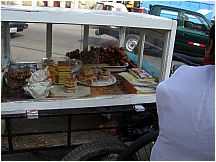 31pisco_.jpg Sweets aboard a vendor's cart in Pisco, near the main square |
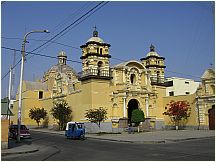 32pisco.jpg Cathedral on the Plaza de Armas of Pisco, Peru |
|
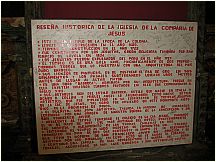 34pisco.jpg Sign telling the history of the Church of the Company of Jesus on the Plaza de Armas of Pisco, Peru |
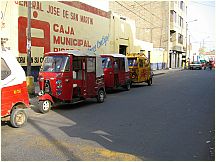 36piscowheelcar.jpg 3-wheel taxis and commercial vehicles predominate in Pisco, Peru. In all of Peru, gas prices are at least as high as in the USA, and generally higher. |
|
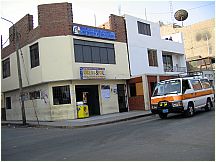 37pisco_.jpg One of the many informal buses operating in Pisco, similar to those in most developing countries around the world. |
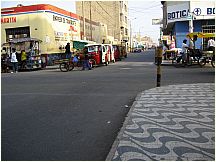 39pisco_.jpg 3-wheel taxis and bicycle propelled carts in Pisco, Peru. Pisco has one of the least capital intensive transportation systems in Peru. |
|
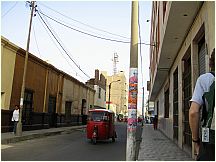 40pisco_.jpg 3-wheel taxis and commercial vehicles predominate in Pisco, Peru. In all of Peru, gas prices are at least as high as in the USA, and generally higher. |
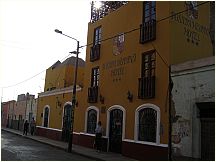 41pisco.jpg The Posada Hispana Hotel in Pisco, with photographer Kristin standing in front. The Hotel has free wireless internet and wonderful, friendly owners. ready to discuss marine conservation in considerable depth. |
|
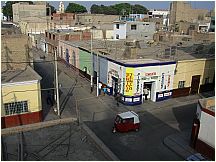 42pisco.jpg View from the roof of the Posada Hispana Hotel in Pisco, showing the neighborhood |
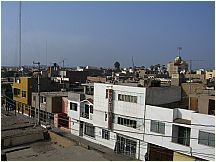 44pisco_.jpg View from the roof of the Posada Hispana Hotel in Pisco, looking away from the main square (Plaza) showing the neighborhood |
|
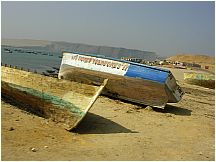 47pisco.jpg Scene showing derelict boats at the port of Pisco, with the cliffs of the Paracas National Reserve in the background |
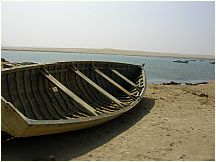 48pisco_.jpg Scene showing derelict boat at the port of Pisco, with the beaches of the Paracas National Reserve in the background |
|
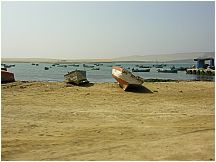 49pisco.jpg Boats on the beach and in the harbor at the port of Pisco, with the cliffs of the Paracas National Reserve in the background |
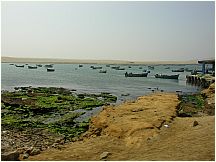 50pisco_.jpg Boats at moorings in the harbor at the port of Pisco, with the beaches of the Paracas National Reserve in the background |
|
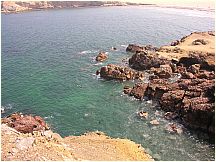 51pisco.jpg Rocky shore at the port of Pisco |
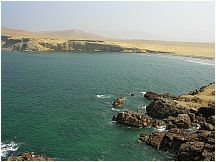 53pisco.jpg Rocky shore at the port of Pisco, with the cliffs of the Paracas National Reserve in the background |
|
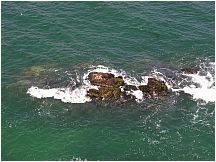 54pisco_.jpg Rocky shore at the port of Pisco |
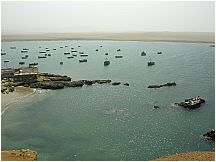 56pisco.jpg Boats at moorings in the harbor at the port of Pisco, with the beaches of the Paracas National Reserve in the background |
|
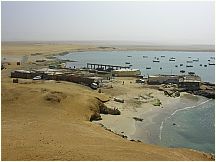 57piscoharbor.jpg Boats at moorings in the harbor and restaurants at the port of Pisco, with the beaches of the Paracas National Reserve in the background |
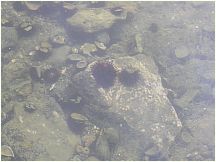 58pisco.jpg Sea urchin and other marine life in the harbor at the port of Pisco |
|
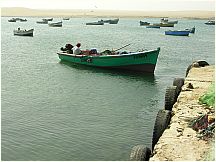 59piscofishingskiff.jpg Artisinal and commercial fishing skiffs at moorings in the harbor at the port of Pisco, with the beaches of the Paracas National Reserve in the background |
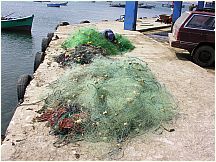 60piscogillnets.jpg Fisherman sound asleep on his gillnet in the harbor at the port of Pisco |
|
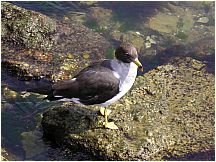 61piscogull.jpg Seagull posing for a picture at the Pisco harbor |
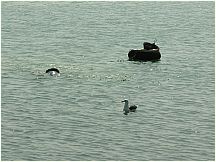 62pisco.jpg Diver collecting shellfish in the harbor at the port of Pisco using a rubber tube and basket to float his catch |
|
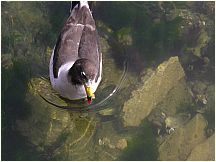 63pisco.jpg Seagull checking out candidates for lunch at the Pisco harbor |
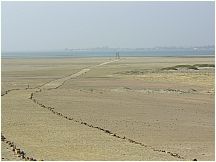 64piscoobservatory.jpg Path to the nature observatory from the Paracas Museum. Flocks of pink flamingos are often in residence in the shallow waters. |
|
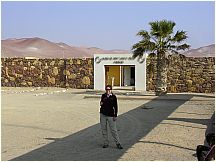 65pisco.jpg Photographer Kimberly standing in front of the Paracas Museum |
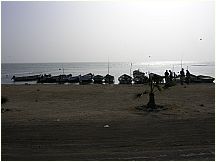 67pisco_.jpg Along the shores between Pisco and the Paracas Park are many types of commercial fishing vessels, mostly tuna seiners and anchovy and sardine purse seiners, and a multitude of skiffs held at anchor or hauled onto the beach when not at sea. |
|
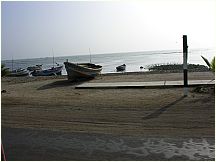 68pisco_.jpg Some of the commercial fishing boats and skiffs along the shores between Pisco and the Paracas Park |
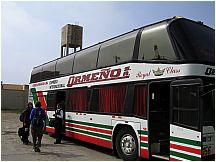 71piscobus.jpg A typical intercity bus moving passengers between cities in Peru. Some have quite large beds on the top decks for overnight trips, such as from Arequipa to Pisco |
|
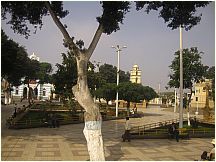 72pisco.jpg Most cities constructed by the Spanish Conquistadores were designed on a standard military fashion based on a grid pattern, taken from the Roman Castrum, of which one of the blocks would be left vacant to form the Plaza de Armas. It is often surrounded by governmental buildings, churches, and other structures of cultural or political significance. The name derives from the fact that this are would be a refuge in case of an attack upon the city, from which arms would be supplied to the defenders. |
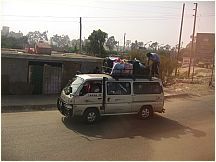 76piscoruralbus.jpg One of the many informal buses operating in Pisco, similar to those in most developing countries around the world. |
|
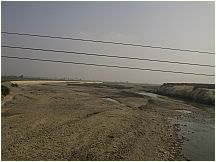 78pisco.jpg River flood area between Pisco and Chincha |
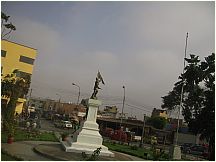 81pisco_chincha.jpg Major traffic circle in Chincha on the road from Pisco to Lima. Chincha was a major administrative center in Inca times |
|
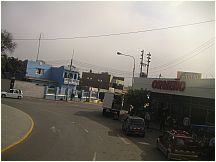 82pisco_chicha.jpg Bus stop in Chincha on the way to Lima from Pisco. There are important Inca ruins in the area, some 190 km south of Lima |
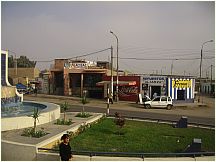 83piscochincha.jpg Traffic island in Chincha on the way to Lima from Pisco |